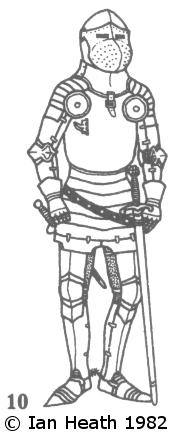
Find the perfect fit with Amazon Prime. Try Before You Buy.
SIR JOHN LEVENTHORPE d.1433
An extract from Armies of the Middle Ages, Volume 1by Ian Heath



10. SIR JOHN LEVENTHORPE d.1433
The armour worn here differs very little from that of figure 8 except in the addition of taces or tasses, which are the small plates attached to the bottom of the fauld. These first appeared c. 1430 and were worn both front and back, being called respectively foretasses and hindtasses (the latter being actually a single plate). After c. 1440 small tasses were sometimes worn at the sides as well (see 122). His helmet, substituted from another source, is a bicoquet or bycocket, a transitional type between the great bascinet and the armet (see note 77) but still bearing a close resemblance to the former. It appeared c. 1390 and was popular in France, England and Germany, remaining in use until the second half of the 15th century. The great bascinet, on the other hand, was little used in war after c.1450 and was relegated to tournament use.
The lance had undergone considerable evolution by this time, resulting in the appearance by the late-14th century of the type depicted in figure 77, thick above the grip and tapering below it. A French military treatise of 1446 confirms that its length was now usually 15 feet. Despite its massive appearance it was in fact quite light, being hollow. In the charge it was by now usually held in a lance-rest (called an arrêt de cuirasse) which was attached to the right of the breastplate by a retaining pin. This device first seems to appear c. 1386, on a German effigy, but was not common until c. 1420. That shown here has been added from another source.